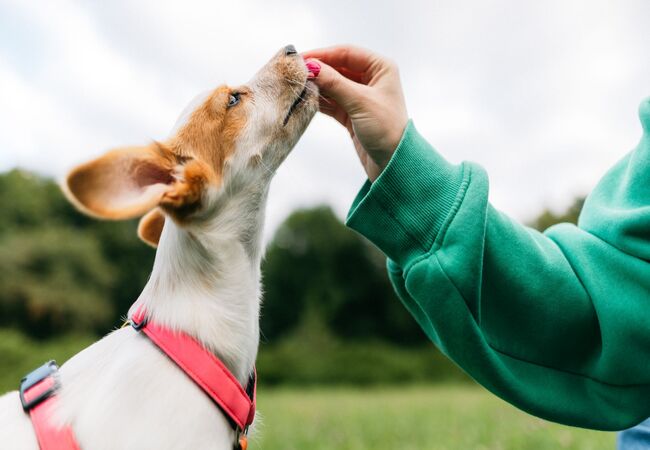How to Train a Dog with Positive Reinforcement in 2025 – Vet‑Approved Science‑Backed Guide 🦴🐾

In this article
How to Train a Dog with Positive Reinforcement in 2025 – Vet‑Approved Science‑Backed Guide 🦴🐾
By Dr. Duncan Houston BVSc
Positive reinforcement training is more than just giving treats—it's a scientifically grounded method based on operant conditioning that teaches dogs desired behaviors through rewards. This guide explores why it works so well, how to apply it effectively, and step-by-step training strategies to cultivate trust, confidence, and long-term obedience in your dog—no punishment needed.
1. The Science Behind Positive Reinforcement
- Operant conditioning: Training is most effective when a behavior is followed by a reward, increasing the likelihood the behavior is repeated.
- Four quadrants: Positive reinforcement (adding reward to increase behavior) outperforms punishment-based methods in building good behavior and well-being.
- Timing & markers: A clicker or marker word identifies the exact moment of desired behavior—this precision speeds learning.
2. Why Reward-Based Training Wins
- Fosters trust: Builds a strong, positive bond instead of fear or avoidance.
- Builds confidence: Encourages active thinking and resilience in new situations.
- Enhances retention: Skills trained with rewards are remembered longer and applied in different contexts.
- Encourages safety: Dogs reliably return to their owners even in distractions because they associate cues with positive outcomes.
- Reduces stress & aggression: Avoids fear-triggered behaviors common in punishment-based methods.
3. Rewards That Work
- Treats – high-value treats help with new or difficult tasks.
- Verbal praise – “Good dog!” with a happy tone reinforces behavior instantly.
- Toys/play – fetch or tug can be more motivating than treats for some dogs.
- Life reinforcement – walks, attention, and access to fun activities serve as real-world rewards.
- Clicker/marker – bridges behavior and reward effectively.
4. Setting Up for Success
- Low-distraction zones for initial learning.
- Plan short sessions – frequent, focused 5–10 minute practices to prevent fatigue.
- Capture desirable behaviors – reward spontaneously when dog offers good behavior.
- Shape harder actions – reward small steps toward the final behavior, gradually raising the criteria.
5. Step-by-Step Training Method
- Define the goal – e.g., “sit” on cue.
- Mark the moment – use a clicker or a marker word.
- Reward promptly – treat or praise immediately after the marker.
- Repeat in short sets with a high success rate.
- Fade treats gradually – switch to variable rewards and praise.
- Generalize cues – train in different settings with distractions.
6. Real‑World Examples
- Loose‑leash walking: praise for no pulling; stop when pulling stops.
- Potty training: praise and treats immediately after an outdoor potty session.
- Crate acceptance: treat when dog enters crate willingly; build comfort gradually.
- Furniture manners: teach “go to bed” and reward for staying off the couch.
7. Common Mistakes & Fixes
- Distraction too early: return to basics if the dog is inconsistent.
- Poor timing: delay between cue, behavior, and click reduces clarity.
- Rewarding wrong behaviors: manage the environment to minimize unwanted options.
- Neglecting fading: mix praise and life rewards to prevent dependency on treats.
8. When Positive Reinforcement Isn’t Enough
In rare cases, dogs may need additional strategies:
- Counter-conditioning for fear – pair low-intensity triggers with rewards to change emotional response.
- Structured management – restrain or block trouble triggers (e.g., front door) until behavior is trained.
- Trainers using balanced approaches may include minimal aversives—but evidence shows pure positive reinforcement is safer and more effective.
9. Long-Term Training & Bonding
- Maintain regular refreshers of core commands in different settings.
- Use novel challenges (e.g., agility, scent games) to reinforce obedience in fun ways.
- Positive reinforcement improves ongoing behavior as your dog learns it’s worthwhile to listen, even years later.
10. 📱 Ask A Vet App 2025 Support
Using the Ask A Vet app, you can:
- 📹 Upload training videos for expert feedback.
- 🧩 Get personalized reinforcement plans tailored to your dog.
- 💬 Access live help from behaviorists if challenges arise.
A supportive expert eye strengthens your training, accelerates learning, and addresses problems early. 🐾📲
❤️ Final Thoughts
Positive reinforcement isn’t just training—it’s relationship-building. By rewarding what you want, you help your dog think, feel secure, and enjoy learning. This method creates confident, reliable, and joyful companions. In 2025, let’s raise dogs with kindness and consistency, achieving effective results without fear or force. 🦴🐾
Scan the QR code to download the Ask A Vet app and get expert-led, reward-based training support tailored to your pup’s journey.






